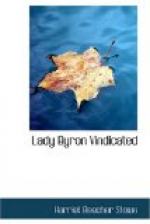And the wild fame of my ungoverned youth,
On things that were not and on things that are,—
Even upon such a basis hast thou built
A monument, whose cement hath been guilt;
The moral Clytemnestra of thy lord,
And hewed down, with an unsuspected sword,
Fame, peace, and hope, and all the better life,
Which, but for this cold treason of thy heart,
Might still have risen from out the grave of strife,
And found a nobler duty than to part.
But of thy virtues didst thou make a vice,
Trafficking with them in a purpose cold,
For present anger and for future gold,
And buying others’ grief at any price.
And thus, once entered into crooked ways,
The early truth, which was thy proper praise,
Did not still walk beside thee, but at times,
And with a breast unknowing its own crimes,
Deceit, averments incompatible,
Equivocations, and the thoughts which dwell
In Janus-spirits; the significant eye
Which learns to lie with silence; the pretext
Of prudence, with advantages annexed;
The acquiescence in all things which tend,
No matter how, to the desired end,—
All found a place in thy philosophy.
The means were worthy, and the end is won:
I would not do by thee as thou hast done!
FOOTNOTES.
{7} The italics are mine.
{14} The italics are mine.
{16} In Lady Blessington’s ‘Memoirs’ this name is given Charlemont; in the late ‘Temple Bar’ article on the character of Lady Byron it is given Clermont. I have followed the latter.
{17} The italics are mine.
{21} In Lady Blessington’s conversations with Lord Byron, just before he went to Greece, she records that he gave her this poem in manuscript. It was published in her ‘Journal.’
{22a} Vol. vi. p.22.
{22b} ‘Byron’s Miscellany,’ vol. ii. p.358. London, 1853.
{23} The italics are mine.
{24} Lord Byron says, in his observations on an article in ‘Blackwood:’ ’I recollect being much hurt by Romilly’s conduct: he (having a general retainer for me) went over to the adversary, alleging, on being reminded of his retainer, that he had forgotten it, as his clerk had so many. I observed that some of those who were now so eagerly laying the axe to my roof-tree might see their own shaken. His fell and crushed him.’
In the first edition of Moore’s Life of Lord Byron there was printed a letter on Sir Samuel Romilly, so brutal that it was suppressed in the subsequent editions. (See Part III.)
{28a} Vol. iv. p.40
{28b} Ibid. p.46.
{31} The italics are mine.
{41} Vol. iv. p.143.
{43} Lord Byron took especial pains to point out to Murray the importance of these two letters. Vol. V. Letter 443, he says: ’You must also have from Mr. Moore the correspondence between me and Lady B., to whom I offered a sight of all that concerns herself in these papers. This is important. He has her letter and my answer.’




